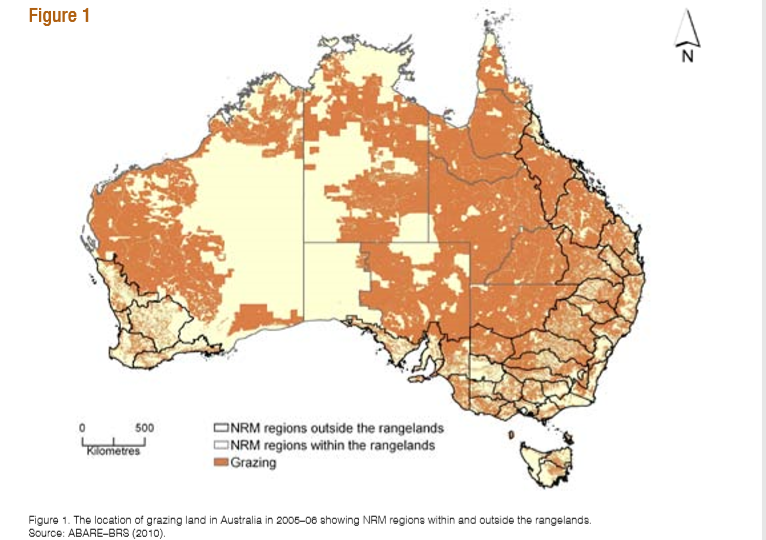Approximately 60% of Australia’s land is used for grazing livestock and growing crops. Another 17% is mined by mining companies. Agriculture and mining utilise 77% of Australia’s total land mass. At least 80% of Australia has been cleared of native vegetation. Australia has lost 25% rainforest, 45% of open forest, 32% woodland forest and 30% of mallee forest in 200 years. Even today, Australia is one of the worst deforestation nations in the world. Australia also has the highest extinction rate in the world due to habitat loss from land clearing. A meagre 7% of Australia’s land is set aside for conservation.

Once upon a time, kangaroos could move freely around Australia. Now 80% of the land has been cleared, which means there is little habitat left for kangaroos. This cleared land poses other problems for kangaroos. Fences stop kangaroos from following their traditional migratory paths. Roads also restrict kangaroo movement. For kangaroos who venture near roads, they are in danger of injury and death.
Given that 80% of the land has been cleared, and only 7% is set aside for conservation, kangaroos often end up on farming land. White settlers (circa 1788) cleared the land for farming, which also meant killing kangaroos. Farmers passed their dislike of kangaroos down through the generations and the killing continued. To this day, a large proportion of farmers believe that they must kill kangaroos. Killing kangaroos is just another chore around the farm left over from white colonisation.
According to governments, Australia has a kangaroo problem. Kangaroos are in the way of development. Once land is used for something else, farming, mining, forestry, towns, there is no longer room for kangaroos. Kangaroos must be killed. But wait? If kangaroos must be killed to make way for human expansion and economic development, the killing creates an opportunity to profit from their dead bodies.
Kangaroos are now killed, and their dead bodies sold for meat and skins.

Making money from dead kangaroos created another problem. There is a finite number of kangaroos but the tiny kangaroo industry, which makes a handful of people very wealthy, is constantly looking for ways to expand to make even more money. The rich get richer because they have an insatiable thirst for wealth. Now the killing of kangaroos is driven by the market for meat and skins, which governments and kangaroo industry are continually trying to increase for the sake of increasing profits.
There is no mistake. Kangaroos are killed for money, just like sheep, cattle, and goats. But unlike sheep, cattle, and goals, kangaroos are wild animals and their numbers are dependent on nature. No one breeds kangaroos. Drought, bushfires, disease, human development, hunting, car accidents, fences, animal abuse, all add up to the killing of millions of kangaroos every year. Kangaroo numbers are in serious decline.
But governments can’t tell the truth about what’s really going on with kangaroos. They know that people won’t like the truth. They know that people will complain. So, governments lie about kangaroos. Governments spread propaganda and they do a great job, meaning that a lot of Australians believe the government lies and allow kangaroos to be killed by the millions every year without batting an eyelid.
The truth is that kangaroos are killed in 5 states for money. Profit. Their dead bodies are sold for meat and skins. Kangaroos are not killed because they are too plentiful. In South Australia, kangaroo populations scientifically considered at risk of extinction are killed to supply meat and skins. Demand is the reason for killing, so much so that kangaroos are disappearing from the Australian landscape. Kangaroos have already disappeared in some regions.
Economics is the only reason that kangaroos are killed. Besides supplying an industry reliant on kangaroo meat and skins, human expansion and economic development displace kangaroos, resulting in decisions to cull them.
Australia is headed for a future where the only kangaroos left will be in zoos and national parks. Governments will be happy with this result. They can manage kangaroo populations in zoos and national parks. They won’t have to worry about pesky kangaroos getting in the way of agriculture, mining, human expansion, or economic development. Yet, kangaroos will be available in national parks for tourists who want to see them.
Not everyone wants this future. Some of us with fight to reveal the truth and try to find a way to co-habitate with our unique Australian wildlife. Unfortunately, right now, too many people believe that kangaroos need to be culled because they are in plague proportions and cause damage.
The truth is that kangaroo numbers are completely unknown due to drought and bushfires. The little evidence we have suggests that kangaroo numbers are at an all time low. Kangaroos should be protected, not culled. Kangaroos need time to recover from all the threats to their survival. They need places to go when human development forces them out.
Instead, kangaroos are killed for money to supply meat and skins to an industry driven by profit.

Kangaroos are culled because they are an inconvenience. Killing is much cheaper than sterilisation or relocation. Hunters cost a lot less than expert teams to perform sterilisation or relocation. Bullets are much cheaper than the supplies these teams might need. Again, money is the driving force behind culling. Killing is the quick, cheap option. Governments want to save money. So, they create more lies to convince people that the quick, cheap option is the best option and thus save themselves money.
Killing kangaroos always comes back to money. No matter how you look at it, kangaroos die so that humans can maximise profits. Culling isn’t necessary. Culling is simply the best answer on the Profit and Loss Statement.
It’s time to look at animals as sentient beings, rather than expenses or profits on a balance sheet. Animals deserve better. There is no valid reason for killing healthy kangaroos.
